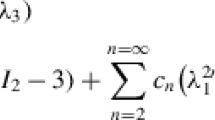Abstract
The Mullins effect in rubber-like materials is inherently anisotropic. However, most constitutive models developed in the past are isotropic. These models cannot describe the anisotropic stress-softening effect, often called the Mullins effect. In this paper a phenomenological three-dimensional anisotropic model for the Mullins effect in incompressible rubber-like materials is developed. The terms, damage function and damage point, are introduced to facilitate the analysis of anisotropic stress softening in rubber-like materials. A material parametric energy function which depends on the right stretch tensor and written explicitly in terms of principal stretches and directions is postulated. The material parameters in the energy function are symmetric second-order damage and shear-history tensors. A class of energy functions and a specific form for the constitutive equation are proposed which appear to simplify both the analysis of the three-dimensional model and the calculation of material constants from experimental data. The behaviour of tensional and compressive ground-state Young’s moduli in uniaxial deformations is discussed. To further justify our model we show that the proposed model produces a transversely anisotropic non-virgin material in a stress-free state after a simple tension deformation. The proposed anisotropic theory is applied to several types of homogenous deformations and the theoretical results obtained are consistent with expected behaviour and compare well with several experimental data.
Similar content being viewed by others
References
Mullins L (1947) Effect of stretching on the properties of rubber. J Rubber Res 16:275–289
Mullins L, Tobin NR (1957) Theoretical model for the elastic behaviour of filler-reinforced vulcanized rubbers. Rubber Chem Technol 30:551–571
Govindjee S, Simo JC (1991) A micro-mechanically based continuum damage model for carbon black-filled rubbers incorporating the Mullin’s effect. J Mech Phys Solids 39:87–112
Ogden RW, Roxburgh DG (1999) A pseudo-elastic model for the Mullins effect in filled rubber. Proc R Soc London A 455:2861–2877
Beatty MF, Krishnaswamy S (2000) A theory of stress-softening in incompressible isotropic materials. J Mech Phys Solids 48:1931–1965
Horgan CO, Ogden RW, Saccomandi G (2004) A theory of stress softening of elastomers based on finite chain extensibility. Proc R Soc London A 460:1737–1754
Qi HJ, Boyce MC (2004) Contitutive model for stretched-induced softening of the stress-stretch behavior of elastomeric materials. J Mech Phys Solids 52:2187–2205
James AG, Green A (1975) Strain energy functions of rubber. II. Characterisation of filled vulcanizates. J Appl Polym Sci 19:2033–2058
Gough J (2005) Stress-strain behaviour of rubber. PhD Thesis Queen Mary and Westfield College, University of London
Pawelski H (2001) Softening behaviour of elastomeric media after loading in changing directions. In: Besdo D, Schuster RH, Ihlemann J (eds). Constitutive models for rubber II. A.A. Balkema Lisse, The Netherlands, pp 27–36
Muhr AH, Gough J, Gregory IH (1999) Experimental determination of model for liquid silicone rubber. In: Muhr A, Dorfmann A (eds) Constitutive models for rubber. A.A. Balkema, Rotterdam, pp 181–187
Shariff MHBM (2005) Multiaxial anisotropic stress-softening constitutive equation. Kauchuk I Rezina 2:16–19
Shariff MHBM, Noor MA (2004) Anisotropic stress-softening model for damaged material. In: Proceedings of the seventh international conference on computational structures technology. Lisbon
Miehe C (1995) Discontinuous and continuous damage evolution in Ogden-type large strain elastic materials. Euro Jl Mech A 14:697–720
Laiarinandrasana L, Layouni K, Piques R (2001) Mullins effect on rubber materials: Damage model driving parameters. In: Besdo D, Schuster RH, and Ihlemann J (eds) Constitutive models for rubber II. A.A. Balkema Publishers Lisse, The Netherlands, pp 149–160
Spencer AJM (1984) Constitutive theory of strongly anisotropic solids. In: Spencer AJM (ed) Constitutive theory of the mechanics of fiber reinforced composites (chapter IX), CISM Courses and Lectures No. 282. Springer, Wien, pp 1–32
Spencer AJM (1971) Theory of invariants. In: Eringen AC (eds) Continuum physics I (Part III). Academic Press, New York, pp 239–353
Valanis KC, Landel RF (1967) The strain-energy function of hyperelastic material in terms of the extension ratios. J Appl Phys 38:2997–3002
Shariff MHBM (2000) Strain energy function for filled and unfilled rubberlike material. Rubber Chem Technol 73:1–21
Shariff MHBM, Parker DF (2000) An extension of Key’s principle to nonlinear elasticity. J Engng Math 37:171–190
Ogden RW (1984) Non-linear deformations. John Wiley, New York
Mullins L (1969) Softening of rubber by deformation. Rubber Chem Technol 42:339–362
Author information
Authors and Affiliations
Corresponding author
Rights and permissions
About this article
Cite this article
Shariff, M.H.B.M. An anisotropic model of the Mullins effect. J Eng Math 56, 415–435 (2006). https://doi.org/10.1007/s10665-006-9051-4
Received:
Accepted:
Published:
Issue Date:
DOI: https://doi.org/10.1007/s10665-006-9051-4




